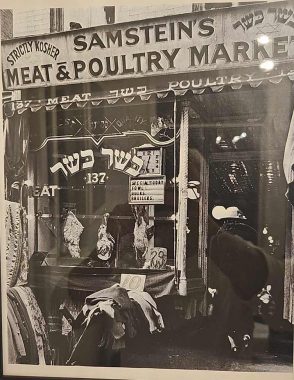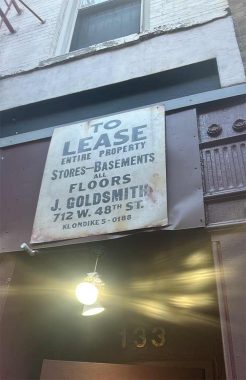
What we’re gonna do right here is go back, way back, back into time, as Sergey visits a movie set starring the hottest name in the business in December 2024, Timothée Chalamet, who plays Bob Dylan in “A Complete Unknown”…
By SERGEY KADINSKY
Forgotten New York correspondent
In September 2024, I was on the Lower East Side for work and used the lunch break to see how much the neighborhood changed since the prior week, that’s how speedy the pace of change is around here. On Eldridge Street, the block between Delancey and Broome streets served as a movie set for the film Marty Supreme, starring Timothee Chalamet. The film depicts the life of table tennis champ Marty Reisman, who was raised on the Lower East Side.
Tenements on the block had their LED and plastic awning displays covered up in favor of 1950s neon letters and hand-painted signage. For a couple of hours, it felt like a walk back in time.

The Chinese Hispanic Grocery at the south end of this block had its name changed to Levenstein’s Food Market, which in movies is the last name of Jim and his father Noah in the memorable raunchy comedy American Pie.

Looking back at the 1940s city tax survey photo of this street corner, the name of this shop at the time is unclear. Next door to it on 286 Broome Street was Harry Greenberg’s Roumanian Casino, founded in 1894 perhaps as the city’s first Romanian restaurant. As late as 1951, it appeared in restaurant guides. I have no idea when Greenberg’s served its last meal. An e-bike shop rented this space in 2024.

On the sidewalk, an imitation of a poster on a brick wall for Ringling Brothers circus speaks of that industry’s leader, known to past generations of New Yorkers for marching elephants through the Midtown Tunnel and its lengthy train that carried the show to the Nassau Coliseum. Its last animal act took place in 2017.
The fake circus posters are pasted on a wall that appears a century old but it’s really a board covering up contemporary wall art and advertisements. In their effort at 1950s authenticity, the filmmakers likely angled the camera to avoid the air conditioners of the second floor, so that only the mural and the actor on the sidewalk walking past it would appear on screen.

The fake brick wall covered a mural painted in 2023 by Jose Aurelio Baez for the Woodward Gallery, which is located at 123A Eldridge Street. The floral theme brings to mind the neighborhood’s history. In the early years of this country, the scene here was rural. Its agrarian past appears on the map with nearby Orchard Street.

At 136 Eldridge Street, two vacant storefronts were transformed into a fake pet shop that offered kittens at $2.75 and puppies at “$3.00 and up.” At the end of 2024 the state law banning the sale of cats and dogs went into effect. No more songs about the cost of doggies in the window. Going forward, such pets can be obtained at an adoption center.
Perhaps the set designer had a set of humor putting a butcher next to a pet shop, as both establishments traffic in animals. Samstein’s Strictly Kosher Meat & Poultry Market has fake kielbasa hanging by the door. It’s obviously fake because there are no flies attracted to it.

In a Facebook group dedicated to kosher food, a descendant of the actual Samstein’s shop pointed out that the store sign is a faithful reproduction but the address is wrong by one digit, and a street. It was actually located at 137 First Avenue, a few blocks to the north. The kosher butcher died in 1948. His son Mendy became a noted civil rights activist, surviving a bomb planted by white supremacists.

A parking restriction sign was laying on the sidewalk, painted with the regulation font of the 1950s. With ongoing battles over parking spaces in Manhattan involving personal vehicles, deliveries, dining sheds, and bike lanes, it’s easy to forget that overnight parking in the city was only permitted in 1954. Prior to that year, street parking was associated with traffic congestion, loitering, car theft, and blocked hydrants. As car ownership became more popular, street parking was seen as a necessity.

Across the street, a fake sign for a lease at 712 W. 48th Street, with an alphanumeric phone number. Our late contributor Gary Fonville wrote a detailed page on other such examples across the city. As a bus driver, he had been to many places and found many more faded ads with these phone numbers. The alphanumeric system was phased out in the 1960s. As for the address on this sign, if it were to exist, it would be in the Hudson River, west of the West Side.

Many more fake period signs stood ready for installation, with antiquated terms such as haberdasher, to-let, luncheonette, or chop suey. The Yiddish here advertises a stamping business, an office item that we rarely see these days. Also notable for its decade are glass milk bottles delivered by the milkman, and a Coca-Cola fridge.

Returning to Woodward Gallery, the windows were changed to show an appliance store offering a stove for $184.95, refrigerator for $230.00, and washing machine for $199.99. These conveniences spoke of the consumer society of the 1950s that made household chores easier. Can you imagine an earlier generation that washed clothing by hand and hung it out to dry, or relied on ice boxes and pickling to preserve food?
One of the city’s leading period prop makers is Eclectic/Encore Props in Long Island City, which Business Insider visited in 2021, with a detailed video tour. Another source for old signage is the New York Sign Museum in East New York, which Kevin visited earlier this year.
Come to see Timothée Chalamet and Gwyneth Paltrow, and stay for the history!
You can learn more about the history of this block and individuals named here by visiting each of the hyperlinks posted in the essay above.
Sergey Kadinsky is the author of Hidden Waters of New York City: A History and Guide to 101 Forgotten Lakes, Ponds, Creeks, and Streams in the Five Boroughs (2016, Countryman Press), adjunct history professor at Touro University and the webmaster of Hidden Waters Blog.
12/28/24


4 comments
If those were what appliances actually cost in the 1950’s they were staggeringly expensive.
Our 1957 $225 Westinghouse 21″ B&W TV would be $2550.00 today. My 43″ Westinghouse flatscreen cost me $150 this summer.
I think I recognize that stove. It was the one my apartment, rented in 1968, came with. Finally died a couple of years ago and ws replaced by the landlord with another relic, with 3 pilot lights I can’t turn off, so oven keeps putting out heat even though I never use it.
Re 712 W. 48th Street: I’m amused how in Law and Order: Special Victims Unit in one of the first episodes the detectives remark how a 700 house number in Manhattan on a cross street is fictitious, that it would be in the river, yet they continue to use such addresses anyway in the series (I also remember they used house numbers for uncompleted / paper streets in Staten Island as well.)